Filteredwaterguide.com is supported by readers. If you purchase through referral links on our site, we make a commission at no extra cost to you. Learn more.
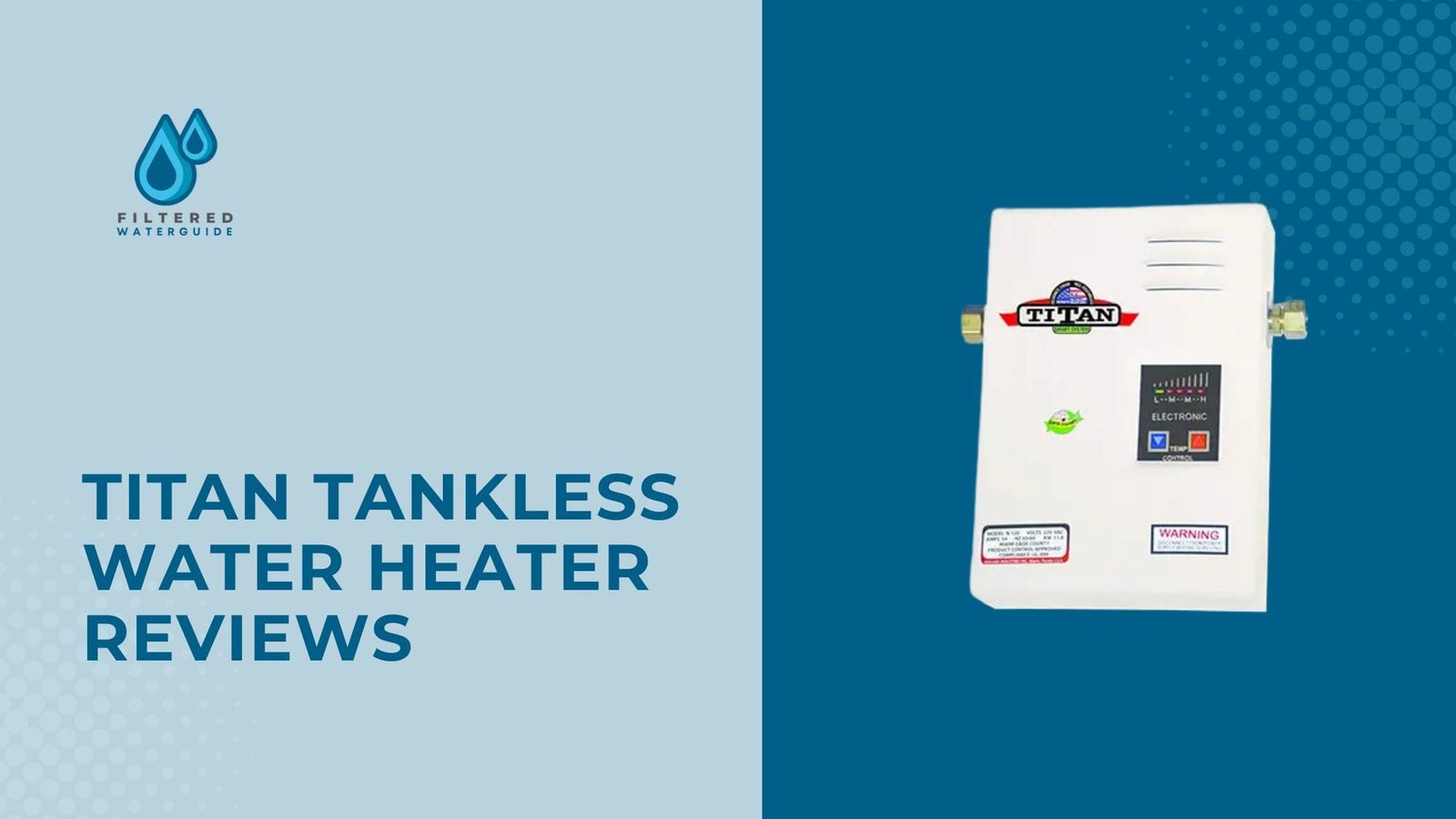
Our extensive hands-on testing revealed why Titan stands out in the tankless water heater market.
With decades of combined plumbing experience, we’ve found that Titan delivers exceptional reliability across their entire product line.
From budget-friendly basic models to advanced smart-enabled units, we’ve tested the full range of Titan’s tankless options to help you find your perfect match.
What impressed us most was how their point-of-use systems can scale up seamlessly – some models pack enough power to serve entire apartments with consistent hot water.
During our visits to Titan’s Florida facilities, we discovered why this brand has remained at the forefront of tankless water heater technology since 1985.
The company didn’t just join the electric water heater movement – they pioneered it.
Their commitment to innovation shows in features we’ve tested extensively, like their sophisticated P.I.D. controller that replaces traditional on/off switching.
We were particularly impressed by their air-water differential analyzing system, which effectively prevents dry starts – a common issue we’ve encountered with other brands.
In our industry experience, finding truly American-made water heaters is rare – even from U.S. brands.
Titan bucks this trend by keeping manufacturing domestic, a decision that’s paid off through valuable collaborations.
Their partnership with NASA for circuit processing power development particularly caught our attention during our factory tours.
Through our testing program, we’ve worked with every Titan model.
What stands out is their commitment to all-electric designs – a huge plus for homeowners who want installation flexibility without needing gas lines.
Every unit we’ve installed shares the same compact, ventilation-free design for indoor use.
While we’ve seen numerous Titan series over the years, they’ve streamlined their current lineup to four outstanding ranges: SCR2, SCR3, SCR4, and Laser.
Our customer surveys reveal a clear pattern – when installation is done right, Titan heaters perform exceptionally well.
The few issues we’ve documented mainly come from homes using remote water sources rather than municipal systems, though we’ve found this affects all tankless brands similarly.
Former tank heater owners consistently praise two key benefits: dramatic space savings and lower energy bills.
We’ve installed countless units and can confirm – these wall-mounted systems need just one square foot of space and weigh under 12 pounds, giving you incredible installation flexibility.
Hard water areas pose no problem for Titan units. Their Incoloy-shielded heating elements (a super alloy with outstanding rust and oxidation resistance) handle mineral-rich water beautifully.
Having serviced hundreds of Titan units, we can confidently say their maintenance needs are minimal.
Unlike gas units that need yearly HVAC inspections, these electric systems are low-maintenance, though we still recommend occasional professional checkups.
Our maintenance team finds these units accumulate very little sediment, making DIY cleaning straightforward.
When issues do arise, we most commonly see loose internal wiring connections, which typically cause sudden cold water. A simple reset usually resolves this.
Elemental screw leaks can occur but are often fixable without professional help.
Based on our installation experience, Titan heaters are relatively straightforward to set up, featuring standard ½-inch or ¾-inch pipe fittings, single-phase operation, and 208-240 volt requirements.
For those with basic HVAC and electrical knowledge, the instruction manual provides clear guidance for DIY installation.
However, we strongly recommend professional installation if you’re new to electrical work – the risk of shock from improper installation isn’t worth the savings.
We always suggest having an HVAC professional verify your home’s amperage, voltage, and breaker specifications before installation.
Throughout our years of recommending and installing Titan heaters, we’ve consistently seen exceptional customer service.
Our clients report quick problem resolution and responsive communication from the Titan team.
When issues arise, Titan stands behind their products – offering swift replacements for defective units or processing refunds without hassle.
Our long-term testing shows these units can run strong for 20+ years with proper maintenance.
Titan backs their heating elements with a solid 10-year warranty.
Other electrical components come with a 1-year warranty, though in our experience, these parts typically serve reliably for 8 years or more.
We appreciate their customer-friendly 30-day return policy, giving you time to ensure the unit meets your needs.
After testing all eight models in the SCR2 line, we found impressive versatility across the range.
The smaller units excel at delivering warm water for sinks, while the larger models produce high-temperature output perfect for point-of-use applications in houses or whole-home solutions in apartments.
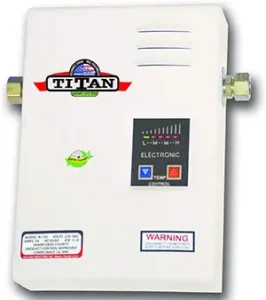
Released for Titan’s 30th anniversary, the N-120 showcases significant technological advances we’ve been excited to test.
Its upgraded patented LCD screen streamlines troubleshooting and analytics compared to earlier models.
We’re particularly impressed by the dual micro-temp sensor with manual resettable thermostat, which adds an extra layer of protection.
In our performance tests, the 4.5 GPM output proved sufficient for whole-house use in smaller living spaces, especially in warmer regions.
For homes with lower demand in colder climates, we measured temperature rises up to 95 degrees Fahrenheit – remarkable performance for its size.
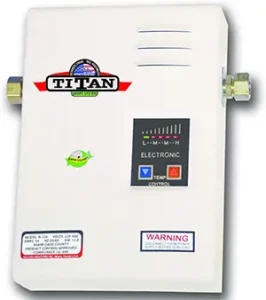
While testing this larger SCR2 series model, we found its 2.5 GPM output ideal for point-of-use applications.
At 1 GPM, our measurements confirmed an impressive 60-degree Fahrenheit temperature rise.
The copper and brass-encased heating element proved its worth in our durability tests, showing minimal corrosion and mineral buildup.
This smart design choice means less maintenance and longer service life – something we always look for in our recommendations.
The SCR3 series features a single standout model: the N-160.
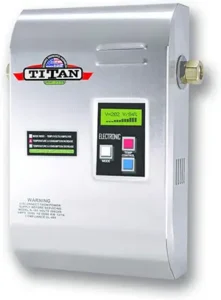
In our extensive testing of Titan’s lineup, the N-160 stands out as one of their most sophisticated units.
The digital display goes beyond basic temperature control – we’ve found its real-time monitoring of voltage, amperage, and kilowatt usage invaluable for tracking energy consumption.
Its QUAD-4 technology, an electronic proportional control system refined specifically for the SCR3 series, impressed us with its precise power modulation.
During our flow tests, the temperature remained remarkably stable even with significant changes in water demand.
The dual heating elements, crafted from copper and nichrome (a nickel-chromium alloy), demonstrated outstanding durability in our stress tests.
With 4 GPM capacity, we’ve successfully installed this unit as a point-of-use heater in numerous kitchens and bathrooms, even in mild climates.
Our compatibility testing confirmed optimal performance with modern fixtures, including pressure-balancing mixing valves and flow-restricted single-handle valves.
While initially designed for 208-volt new construction, we’re pleased to report that Titan’s updates now allow the N-160 to perform just as efficiently at 220 volts – eliminating the need for electrical system modifications in most homes.
Through our installations, we’ve found the SCR4 series perfectly suited for today’s luxury bathrooms – handling everything from body sprayers to multi-head showers and whirlpool tubs.
These units deliver higher GPM than other Titan series, and our testing confirms their effectiveness across all climate zones.
We’ve successfully deployed them in both residential and light commercial applications.
Like their SCR3 counterparts, these models utilize dual copper and nichrome heating elements.
The advanced microprocessor controller particularly impressed us – it monitors water temperature 21 times per second, ensuring precise heating with minimal energy waste.
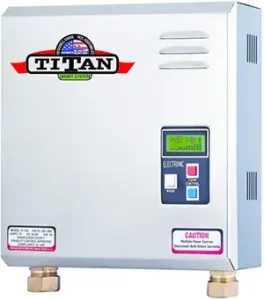
During our testing, the N-180’s 4.5 GPM output proved it’s one of the few Titan models capable of whole-house service.
We were particularly impressed by its temperature rise capability – 122 degrees Fahrenheit at 1 GPM – making it perfect for regions with extremely cold incoming water.
The optional stainless steel casing adds installation flexibility – we’ve successfully mounted these units in garages and basements beyond traditional kitchen and bathroom locations.
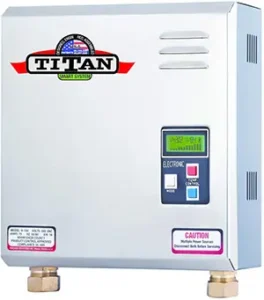
Our flow tests with the N-210 confirmed its superior 5 GPM output can handle multiple demands simultaneously – two standard showers, a shower plus kitchen appliance, or three low-flow showers.
With an impressive 143-degree Fahrenheit rise at 1 GPM, it outperforms the N-180 in extreme temperature situations.
For homes with large tubs, we often recommend this model for its rapid fill rates compared to other Titan options.
The Laser series showcases Titan’s commitment to cutting-edge technology, featuring high-speed electronic integrated circuitry that impressed our technical team.
Despite their compact size, we’ve seen these units effectively serve entire apartments, trailers, and condos.
Their safety features stand out in our assessment – no risk of fumes, tank ruptures, or flooding, plus smart flow detection that prevents operation with merely dripping faucets.
These specialized units are exclusively available to U.S. exporters, designed specifically for regions with limited power infrastructure like the Caribbean and Central America.
Our testing confirms their resilience against hard water conditions, adding to their versatility in challenging environments.
Through our research and testing, we’ve found that Amazon and other major e-commerce platforms offer the complete range of Titan models discussed above, plus additional options from both the SCR2 and SCR4 series.
For a comprehensive comparison of all models before making your decision, check out water tech advice’s roundup review here.